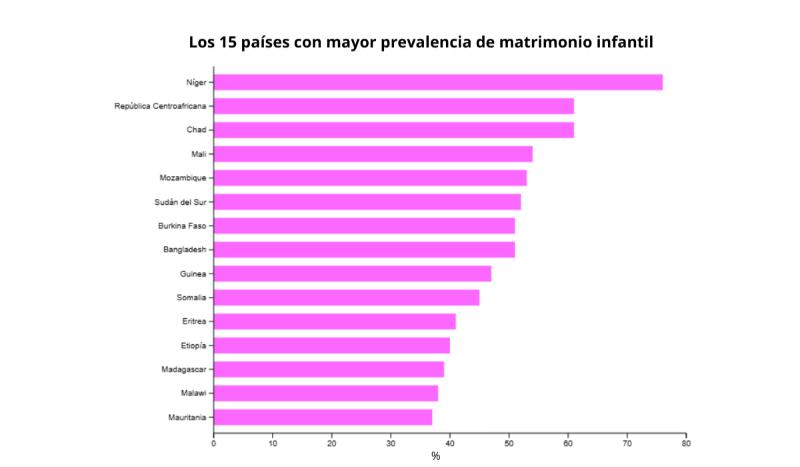Every 3 Seconds: The Global Child Marriage Crisis

This visualization shows that every 3 seconds, somewhere in the world, a girl gets married before the age of 18. That’s 28,800 girls each day.
Child marriage is a practice that violates children’s rights and primarily affects girls. It is defined as a formal or informal union in which at least one of the parties is under 18 years old. This transgression not only deprives and limits girls’ access to and enjoyment of their rights but also exposes them to gender-based violence, perpetuating cycles of inequality.
According to UNICEF, there are currently around 640 million women and girls who were married at an early age, and each year, approximately 12 million girls are forced into marriage. While this issue also affects boys, the prevalence among girls is six times higher due to deep-rooted gender inequalities.
Poverty, lack of access to education and healthcare, as well as entrenched gender norms, are key social inequality factors that drive these practices. Many families see marriage as a strategy to reduce their economic burden or ensure their daughters’ safety in times of crisis. In other cases, it is considered a way to “protect” girls from out-of-wedlock pregnancies, reinforcing patriarchal norms that limit their autonomy.
Global Trends in Child Marriage: Where and How Does It Happen?
The prevalence of child marriage varies significantly between regions. The highest rates in the world are recorded in:
- West and Central Africa, where 40% of young women marry before the age of 18.
- East and Southern Africa, where 32% of girls marry in childhood.
- South Asia, which accounts for 45% of the world’s child marriages. However, in the past decade, the proportion of girls marrying before 18 in the region has significantly decreased, dropping from nearly 50% to less than 30%.

Percentage of women aged 20 to 24 who were first married or in a union before age 18. Source: UNICEF Global Databases 2024.
Discover more regional statistics by visiting our database.
Although the global proportion of young women married at an early age has decreased over the last five years, dropping from 21% to 18%, it remains a severe issue, particularly in countries where there is no legal minimum age for marriage or where the law sets different ages for men and women.
Advancing tools and conditions to eradicate this issue remains a collective challenge. The Sustainable Development Goals (SDGs) set the target of eliminating child marriage by 2030. Achieving this goal would require an acceleration of current progress—without urgent action to speed up the current decline by 20 times, over the next decade, more than 100 million girls will be married before their 18th birthday.
How Does Child Marriage Affect Girls?
Impact on Education and Well-being: Girls who marry in childhood face immediate and lifelong consequences. Their likelihood of staying in school decreases, while their risk of early pregnancies increases, leading to maternal and child health complications and mortality. These situations not only isolate them from their support networks but also severely affect their emotional well-being and mental health.
Urban-Rural Divide: Globally, 13.7% of women under 18 living in urban areas were married, compared to 27% in rural areas. This disparity exists across all regions, but it is particularly pronounced in Sub-Saharan Africa, where 40.4% of rural women married before 18, compared to 16% in urban areas.
Violence and Power Imbalances: The trend shows that girls who marry before 18 are more likely to experience violence from their partners. For instance, in Colombia, 55% of adolescent mothers have experienced some form of violence from their partners within the first year of marriage. Alarmingly, 49% of girls under 15 who became mothers had children with men who were 5 to 9 years older, while 19% had children with men who were at least 10 years older. These statistics highlight how age differences translate into deep inequalities and power imbalances.
The role of the data community in the fight against child marriage is to produce accurate and up-to-date data for each region of the world. In many countries, official statistics are scarce or nonexistent, making it difficult to fully understand the scope of the problem and limiting the ability to design effective public policies and strategies. Without disaggregated data by age, location, and socioeconomic conditions, it is impossible to prioritize efforts and allocate resources where they are most needed.